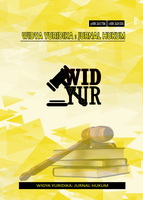Rekam Medis Elektronik Berbasis Cloud Computing: Pertanggungjawaban Hukum Akibat Kebocoran Data Pasien
DOI:
https://doi.org/10.31328/wy.v8i1.5864Keywords:
Health Data, Healthcare Facilities, Right to Privacy; Ministry of Health, Electronic Medical RecordsAbstract
The primary objective of this research is to analyze legal liability in breach of patient’s medical record in SatuSehat platform that provides Cloud Computing-based electronic medical record. This research is a document study or normative legal research that uses conceptual approach and statute approach. The Omnibus Health Law and Minister of Health Regulation about Medical Records require in implementation of medical records must be in electronic form or electronic medical records. As a result of this obligation, legal issue arises related to the protection and confidentiality of patient data which stored and managed by electronic medical record’s administrator. Focus of this research is the implementation of a cloud computing-based electronic system through a system developed by the Ministry of Health which is SatuSehat. This research shows that the party who legally liable for the implementation of Cloud Computing-based electronic medical records is the Ministry of Health, the reason is because there is a transfer of legal liability from healthcare facility to the Ministry of Health because initially the patient data is received by the healthcare facility, and then integrated into the Cloud Computing-based electronic medical record. So because of that, Ministry of Health as a party who has full authority of the data that has been received and integrated in SatuSehat system must held the responsibility if there is a problem with the data. Therefore, the purpose of this study is not only to analyze of the legal responsibility but also to provide legal basis for the protection of hospitals, doctors and patients in the event of a data leak in the SatuSehat Platform. In addition, authors analyzes the protection principles applied in Indonesia with three pillars of patient health data protection applied in the United States.References
DAFTAR PUSTAKA
Buku
Fardiansyah , H., Rizkia, D. N., Sadi , M., Busroh, F. F., Lobo, F., Pratama, F., . . . Sinaga, L. B. (2023). Pengantar Ilmu Hukum. Badung: CV Intelektual Manifes Media.
Muhaimin. (2020). Metode Penelitian Hukum. Nusa Tenggara Barat: Mataram University Press.
Jurnal
Almaghrabi, N, S., & Bugis, B, A. (2022). Patient Confidentiality of Electronic Health Records: A Recent Review of the Saudi Literature. Dr. Sulaiman Al Habib Medical Journal, 4,126-135.
Bramanta, D, G., & Utari, A, A, S. 2017. Hubungan Hukum Antara Pelaku Usaha Dengan Konsumen. Jurnal Kertha Semaya, 5(1), 1-5.
Fatmawati, A., & Hermono, B. (2016). Perlindungan Hukum atas Data Pengguna oleh Penyedia Layanan Cloud Computing ditinjau dari Undang-Undang Nomor 11 Tahun 2008 tentang Informasi dan Transaksi Elektronik. Novum: Jurnal Hukum, 3(3), 1-10.
Hossain, M., & Hong, Alicia. (2020). Trends and Characteristics of Protected Health Information Breaches in the United States. AMIA Annual Symposium Proceedings Archive, 1081-1090.
Keshta, I., & Odeh, A. (2021). Security and Privacy of Electronic Health Records: Concerns and Challenges. Egyptian Informatics Journal, 22, 177-183. Doi: https://doi.org/10.1016/j.eij.2020.07.003
Naik, N., Hameed, Z., Shetty, D., Swain , D., Shah, M., Paul, R., . . . Somani, B. (2022). Legal and Ethical Consideration in Artificial Intelligence in Healthcare: Who Takes Responsibility. Frontiers in Surgery, 9(862322), 1-6. Doi: https://doi.org/10.3389/fsurg.2022.862322
Priscyllia, F. (2019). Perlindungan Privasi Data Pribadi Perspektif Perbandingan Hukum. Jatiswara, 34 (3), 239-249.
Putra, A., & Sidi, S. (2023). Tanggungjawab Hukum Pihak Ketiga dan Rumah Sakit terhadap Penyelenggaraan Electronic Medical Record. Jurnal Ilmiah Ilmu Pendidikan, 6(8), 6280-6289.
Putra, C, A., & Masnu, M, A. (2022). Analisis Pertanggungjawaban Rumah Sakit terkait Potensi Kebocoran Data Rekam Medis Elektronik Akibat Cyber Crime. Novum: Jurnal Hukum Membudayakan Literasi Hukum , 9(2), 1-14. Doi: https://doi.org/10.2674/novum.v0i0.41286
Rizqy, M, F. (2015). Implikasi Yuridis Putusan MK Nomor 46/PUU-VIII/2010 Terkait Perlindungan Hak Anak. Yuridika, 30(2), 278-306. Doi: https://doi.org/10.20473/ydk.v30i2.4652
Rosadi, S, D. (2016). Konsep Perlindungan Hukum atas Privasi dan Data Pribadi dikaitkan dengan Penggunaan Cloud Computing di Indonesia. Yustitia, 5(1), 22-30. Doi: https://dx.doi.org/10.20961/yustisia.v5i1.8712
Tertulino, R., Antunes, N., & Morais, H. (2023). Privacy in Electronic Health Records: “A systematic Mapping Studyâ€. Journal of Public Health, 32, 435-454. Doi: https://doi.org/10.1007/s10389-022-01795-z
Yuniarti, S. (2019). Perlindungan Hukum Data Pribadi di Indonesia. Jurnal Business Economic, Communication, and Social Sciences, 1(1), 147-154. Doi: https://doi.org/10.21512/becossjournal.v1i1.6030
Website
Alder, Steve. 2023. October 2023 Healthcare Data Breach Report. Diambil Januari 19, 2024. Dari https://www.hipaajournal.com/october-2023-healthcare-data-breach-report
Puspapertiwi, E., & Nugroho, R, S. 2023. PeduliLindungi Jadi Satu Sehat Mulai 1 Maret 2023, Apa Saja Fiturnya?. Diambil Februari 1, 2024. Dari https://www.kompas.com/tren/read/2023/02/28/173000965/pedulilindungi-jadi-satu-sehat-mulai-1-maret-2023-apa-saja-fiturnya-?page=all
Septiani, L. 2022. Kominfo Selidiki 33 Dugaan Data Bocor Tahun Ini, Ada PeduliLindungi. Diambil Februari 1, 2024, Dari https://katadata.co.id/desysetyowati/digital/637f2d191631e/kominfo-selidiki-33-dugaan-data-bocor-tahun-ini-ada-pedulilindungi#google_vignette
Downloads
Published
How to Cite
Issue
Section
License
Copyright (c) 2025 Kezia Annabel Rinda Putri, Oliviani Yanto, Dyah Hapsari Prananingrum

This work is licensed under a Creative Commons Attribution-ShareAlike 4.0 International License.
AttributionYou must give appropriate credit, provide a link to the license, and indicate if changes were made. You may do so in any reasonable manner, but not in any way that suggests the licensor endorses you or your use.
ShareAlike If you remix, transform, or build upon the material, you must distribute your contributions under the same license as the original.
Widya Yuridika: Jurnal Hukum allows readers to read, download, copy, distribute, print, search, or link to its articles' full texts and allows readers to use them for any other lawful purpose. The journal allows the author(s) to hold the copyright without restrictions. Finally, the journal allows the author(s) to retain publishing rights without restrictions
- Authors are allowed to archive their submitted article in an open access repository
- Authors are allowed to archive the final published article in an open access repository with an acknowledgment of its initial publication in this journal
========================================
Editor-in-Chief
Widya Yuridika: Journal of Law.
Faculty of Law, Universitas Widya Gama, Malang, Indonesia.

















